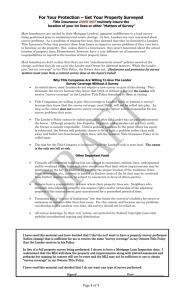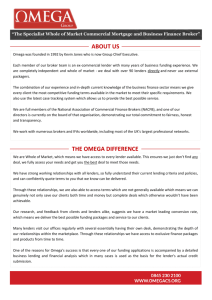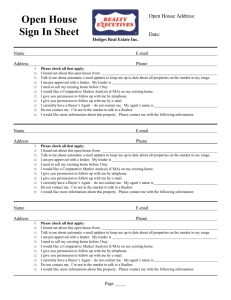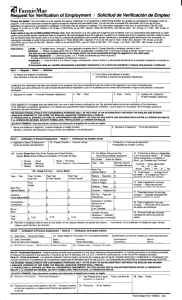COUNSELOR’S CORNER
advertisement
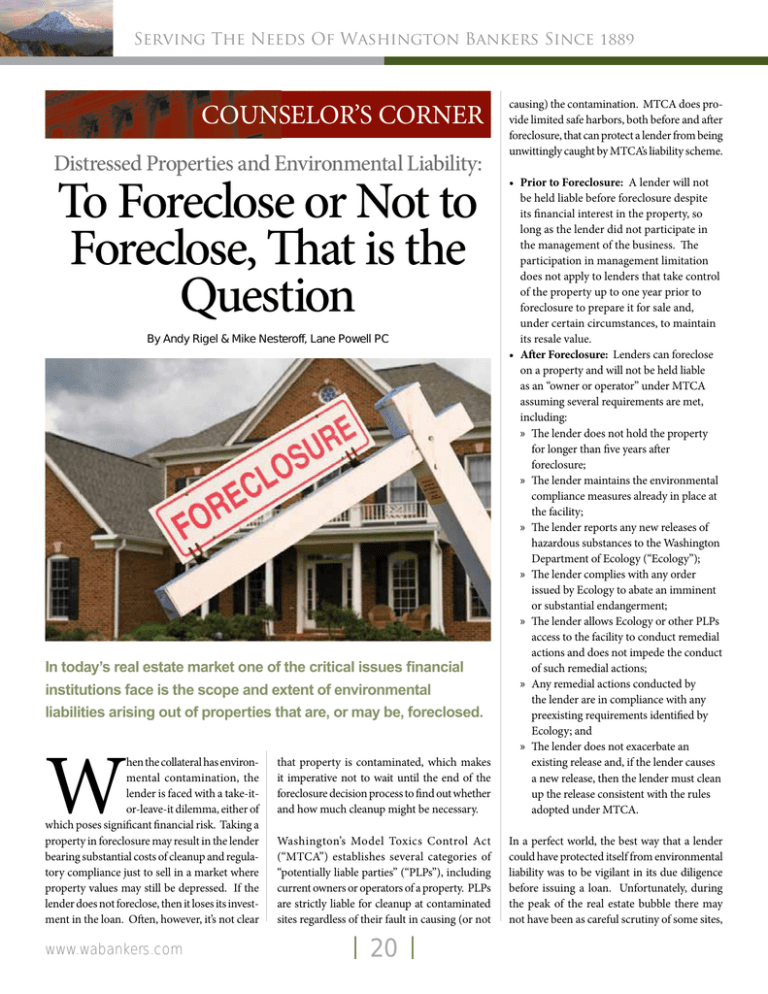
Serving The Needs Of Washington Bankers Since 1889 COUNSELOR’S CORNER Distressed Properties and Environmental Liability: that property is contaminated, which makes it imperative not to wait until the end of the foreclosure decision process to find out whether and how much cleanup might be necessary. • Prior to Foreclosure: A lender will not be held liable before foreclosure despite its financial interest in the property, so long as the lender did not participate in the management of the business. The participation in management limitation does not apply to lenders that take control of the property up to one year prior to foreclosure to prepare it for sale and, under certain circumstances, to maintain its resale value. • After Foreclosure: Lenders can foreclose on a property and will not be held liable as an “owner or operator” under MTCA assuming several requirements are met, including: » The lender does not hold the property for longer than five years after foreclosure; » The lender maintains the environmental compliance measures already in place at the facility; » The lender reports any new releases of hazardous substances to the Washington Department of Ecology (“Ecology”); » The lender complies with any order issued by Ecology to abate an imminent or substantial endangerment; » The lender allows Ecology or other PLPs access to the facility to conduct remedial actions and does not impede the conduct of such remedial actions; » Any remedial actions conducted by the lender are in compliance with any preexisting requirements identified by Ecology; and » The lender does not exacerbate an existing release and, if the lender causes a new release, then the lender must clean up the release consistent with the rules adopted under MTCA. Washington’s Model Toxics Control Act (“MTCA”) establishes several categories of “potentially liable parties” (“PLPs”), including current owners or operators of a property. PLPs are strictly liable for cleanup at contaminated sites regardless of their fault in causing (or not In a perfect world, the best way that a lender could have protected itself from environmental liability was to be vigilant in its due diligence before issuing a loan. Unfortunately, during the peak of the real estate bubble there may not have been as careful scrutiny of some sites, To Foreclose or Not to Foreclose, That is the Question By Andy Rigel & Mike Nesteroff, Lane Powell PC In today’s real estate market one of the critical issues financial institutions face is the scope and extent of environmental liabilities arising out of properties that are, or may be, foreclosed. W hen the collateral has environmental contamination, the lender is faced with a take-itor-leave-it dilemma, either of which poses significant financial risk. Taking a property in foreclosure may result in the lender bearing substantial costs of cleanup and regulatory compliance just to sell in a market where property values may still be depressed. If the lender does not foreclose, then it loses its investment in the loan. Often, however, it’s not clear www.wabankers.com causing) the contamination. MTCA does provide limited safe harbors, both before and after foreclosure, that can protect a lender from being unwittingly caught by MTCA’s liability scheme. 20 Serving The Needs Of Washington Bankers Since 1889 leading to unpleasant surprises in the aftermath. One of the many lessons from the Great Recession is that there was and is no substitute for good underwriting. From an environmental standpoint that includes, at a bare minimum, a Phase I Environmental Site Assessment. The purpose of Phase I is to identify activities known to be likely sources of pollution or locations on the property where there are signs of pollution such as stressed vegetation. And, while Phase I is largely a records search combined with interviews and a visual inspection of the property, many lenders in a rush to beat the competition either didn’t bother with Phase Is or ignored the red flags and failed to do further testing for subsurface problems. Such due diligence is not cheap, but this is one area where an ounce of prevention could have avoided the prospect of expensive and lengthy investigations and cleanup. Today, a lender evaluating whether to foreclose should make sure to conduct thorough due diligence, including a Phase I and, where appropriate, a Phase II Environmental Site Assessment. This requires, among other things, time. Adequate due diligence cannot be started at the end of the evaluation process, but should be started early on to allow sufficient opportunity to collect and evaluate information about the environmental risks associated with the property well in advance of the decision to go through with a foreclosure sale. In addition to providing information to determine whether the lender liability protections in MTCA apply, the Phase I site assessment can also be used to satisfy the prerequisites for other statutory liability protections, such as the innocent purchaser defense. Lastly, environmental due diligence also will aid a lender who should be working on its divestment plan before foreclosing on any contaminated property. The five-year holding period afforded by the lender liability provisions seemed more than adequate protection for lenders when the provisions were incorporated into MTCA in 1995. However, in today’s real estate market, where many properties are substantially more difficult to sell, especially with the stigma of contamination, and in an era when cleanups have gotten more complex and time consuming due to very stringent cleanup standards, lenders may now find themselves running up against the time limit with more regularity. The cost of doing thorough due diligence may seem unnecessary in the vast majority of real estate transactions, but it’s a small price to pay to avoid the pitfalls of being stuck with a property plagued by poor environmental conditions. Michael A. Nesteroff is a shareholder and chair of Lane Powell PC’s Sustainability and Climate Change Team, and a member of the Firm’s Construction and Environmental Litigation Practice Group. Andrew F. Rigel is an attorney at Lane Powell and a member of the Firm’s Sustainability and Climate Change Team, and also a member of the Construction and Environmental Litigation Practice Group. Mike can be reached at nesteroffm@lanepowell.com or 206.223.6242. Andy can be reached at rigela@lanepowell.com or 206.223.7066. 21 May/June 2012

